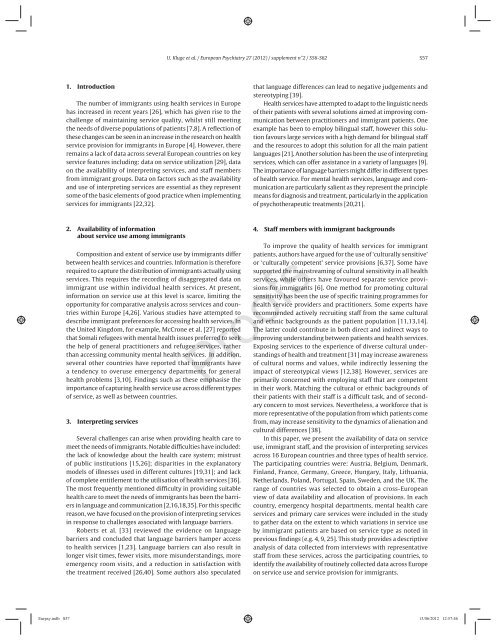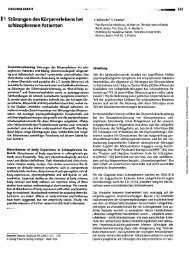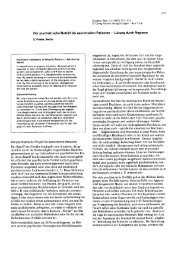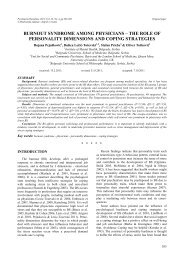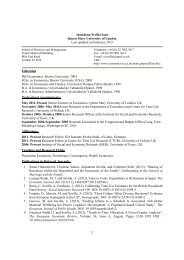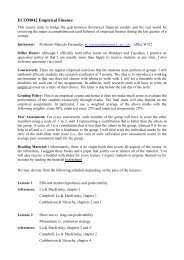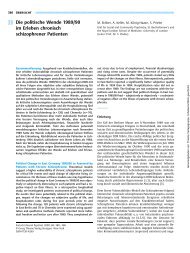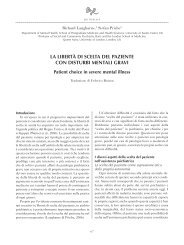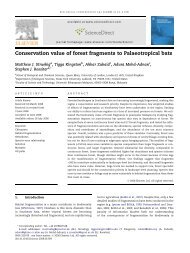Proofs - Personal Webspace for QMUL - Queen Mary, University of ...
Proofs - Personal Webspace for QMUL - Queen Mary, University of ...
Proofs - Personal Webspace for QMUL - Queen Mary, University of ...
Create successful ePaper yourself
Turn your PDF publications into a flip-book with our unique Google optimized e-Paper software.
1. Introduction<br />
The number <strong>of</strong> immigrants using health services in Europe<br />
has increased in recent years [26], which has given rise to the<br />
challenge <strong>of</strong> maintaining service quality, whilst still meeting<br />
the needs <strong>of</strong> diverse populations <strong>of</strong> patients [7,8]. A refl ection <strong>of</strong><br />
these changes can be seen in an increase in the research on health<br />
service provision <strong>for</strong> immigrants in Europe [4]. However, there<br />
remains a lack <strong>of</strong> data across several European countries on key<br />
service features including: data on service utilization [29], data<br />
on the availability <strong>of</strong> interpreting services, and staff members<br />
from immigrant groups. Data on factors such as the availability<br />
and use <strong>of</strong> interpreting services are essential as they represent<br />
some <strong>of</strong> the basic elements <strong>of</strong> good practice when implementing<br />
services <strong>for</strong> immigrants [22,32].<br />
2. Availability <strong>of</strong> in<strong>for</strong>mation<br />
about service use among immigrants<br />
Composition and extent <strong>of</strong> service use by immigrants differ<br />
between health services and countries. In<strong>for</strong>mation is there<strong>for</strong>e<br />
required to capture the distribution <strong>of</strong> immigrants actually using<br />
services. This requires the recording <strong>of</strong> disaggregated data on<br />
immigrant use within individual health services. At present,<br />
in<strong>for</strong>mation on service use at this level is scarce, limiting the<br />
opportunity <strong>for</strong> comparative analysis across services and countries<br />
within Europe [4,26]. Various studies have attempted to<br />
describe immigrant preferences <strong>for</strong> accessing health services. In<br />
the United Kingdom, <strong>for</strong> example, McCrone et al. [27] reported<br />
that Somali refugees with mental health issues preferred to seek<br />
the help <strong>of</strong> general practitioners and refugee services, rather<br />
than accessing community mental health services. In addition,<br />
several other countries have reported that immigrants have<br />
a tendency to overuse emergency departments <strong>for</strong> general<br />
health problems [3,10]. Findings such as these emphasise the<br />
importance <strong>of</strong> capturing health service use across different types<br />
<strong>of</strong> service, as well as between countries.<br />
3. Interpreting services<br />
Several challenges can arise when providing health care to<br />
meet the needs <strong>of</strong> immigrants. Notable diffi culties have included:<br />
the lack <strong>of</strong> knowledge about the health care system; mistrust<br />
<strong>of</strong> public institutions [15,26]; disparities in the explanatory<br />
models <strong>of</strong> illnesses used in different cultures [19,31]; and lack<br />
<strong>of</strong> complete entitlement to the utilisation <strong>of</strong> health services [36].<br />
The most frequently mentioned diffi culty in providing suitable<br />
health care to meet the needs <strong>of</strong> immigrants has been the barriers<br />
in language and communication [2,16,18,35]. For this specifi c<br />
reason, we have focused on the provision <strong>of</strong> interpreting services<br />
in response to challenges associated with language barriers.<br />
Roberts et al. [33] reviewed the evidence on language<br />
barriers and concluded that language barriers hamper access<br />
to health services [1,23]. Language barriers can also result in<br />
longer visit times, fewer visits, more misunderstandings, more<br />
emergency room visits, and a reduction in satisfaction with<br />
the treatment received [26,40]. Some authors also speculated<br />
U. Kluge et al. / European Psychiatry 27 (2012) / supplement n°2 / S56-S62 S57<br />
that language differences can lead to negative judgements and<br />
stereotyping [39].<br />
Health services have attempted to adapt to the linguistic needs<br />
<strong>of</strong> their patients with several solutions aimed at improving communication<br />
between practitioners and immigrant patients. One<br />
example has been to employ bilingual staff, however this solution<br />
favours large services with a high demand <strong>for</strong> bilingual staff<br />
and the resources to adopt this solution <strong>for</strong> all the main patient<br />
languages [21]. Another solution has been the use <strong>of</strong> interpreting<br />
services, which can <strong>of</strong>fer assistance in a variety <strong>of</strong> languages [9].<br />
The importance <strong>of</strong> language barriers might differ in different types<br />
<strong>of</strong> health service. For mental health services, language and communication<br />
are particularly salient as they represent the principle<br />
means <strong>for</strong> diagnosis and treatment, particularly in the application<br />
<strong>of</strong> psychotherapeutic treatments [20,21].<br />
4. Staff members with immigrant backgrounds<br />
To improve the quality <strong>of</strong> health services <strong>for</strong> immigrant<br />
patients, authors have argued <strong>for</strong> the use <strong>of</strong> ‘culturally sensitive’<br />
or ‘culturally competent’ service provisions [6,37]. Some have<br />
supported the mainstreaming <strong>of</strong> cultural sensitivity in all health<br />
services, while others have favoured separate service provisions<br />
<strong>for</strong> immigrants [6]. One method <strong>for</strong> promoting cultural<br />
sensitivity has been the use <strong>of</strong> specifi c training programmes <strong>for</strong><br />
health service providers and practitioners. Some experts have<br />
recommended actively recruiting staff from the same cultural<br />
and ethnic backgrounds as the patient population [11,13,14].<br />
The latter could contribute in both direct and indirect ways to<br />
improving understanding between patients and health services.<br />
Exposing services to the experience <strong>of</strong> diverse cultural understandings<br />
<strong>of</strong> health and treatment [31] may increase awareness<br />
<strong>of</strong> cultural norms and values, while indirectly lessening the<br />
impact <strong>of</strong> stereotypical views [12,38]. However, services are<br />
primarily concerned with employing staff that are competent<br />
in their work. Matching the cultural or ethnic backgrounds <strong>of</strong><br />
their patients with their staff is a diffi cult task, and <strong>of</strong> secondary<br />
concern to most services. Nevertheless, a work<strong>for</strong>ce that is<br />
more representative <strong>of</strong> the population from which patients come<br />
from, may increase sensitivity to the dynamics <strong>of</strong> alienation and<br />
cultural differences [38].<br />
In this paper, we present the availability <strong>of</strong> data on service<br />
use, immigrant staff, and the provision <strong>of</strong> interpreting services<br />
across 16 European countries and three types <strong>of</strong> health service.<br />
The participating countries were: Austria, Belgium, Denmark,<br />
Finland, France, Germany, Greece, Hungary, Italy, Lithuania,<br />
Netherlands, Poland, Portugal, Spain, Sweden, and the UK. The<br />
range <strong>of</strong> countries was selected to obtain a cross- European<br />
view <strong>of</strong> data availability and allocation <strong>of</strong> provisions. In each<br />
country, emergency hospital departments, mental health care<br />
services and primary care services were included in the study<br />
to gather data on the extent to which variations in service use<br />
by immigrant patients are based on service type as noted in<br />
previous fi ndings (e.g. 4, 9, 25]. This study provides a descriptive<br />
analysis <strong>of</strong> data collected from interviews with representative<br />
staff from these services, across the participating countries, to<br />
identify the availability <strong>of</strong> routinely collected data across Europe<br />
on service use and service provision <strong>for</strong> immigrants.<br />
<strong>Pro<strong>of</strong>s</strong>


